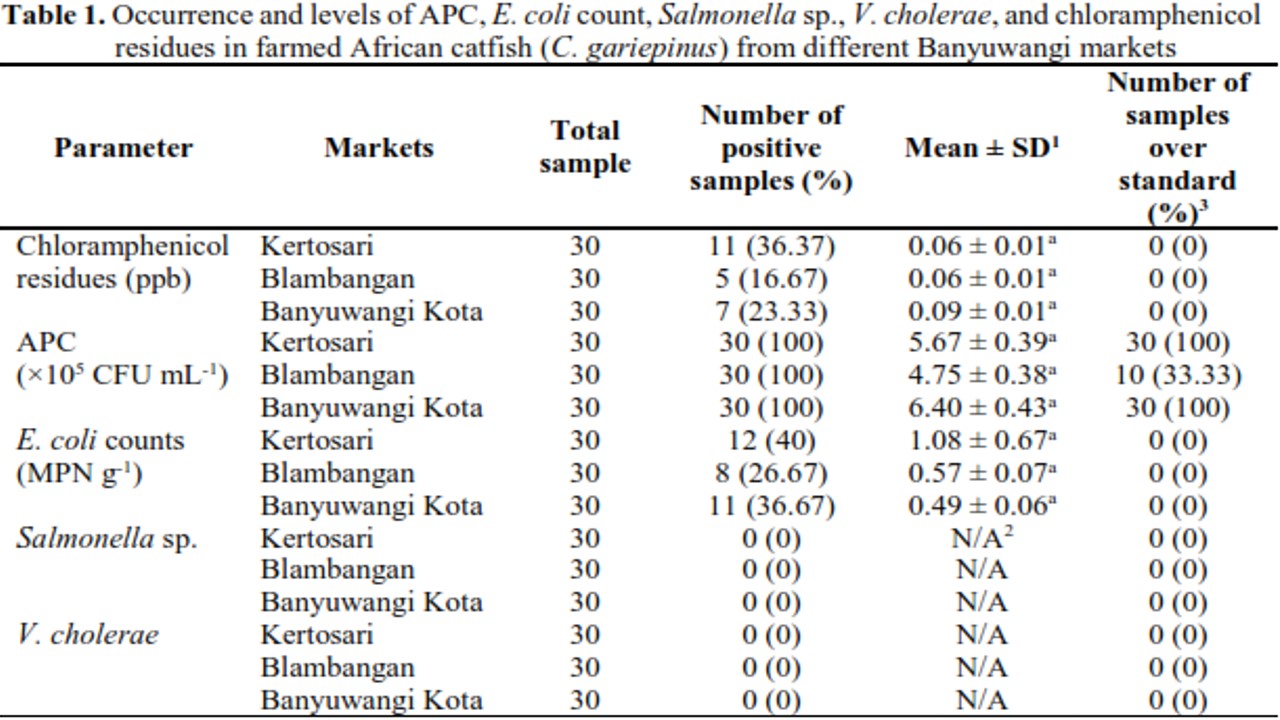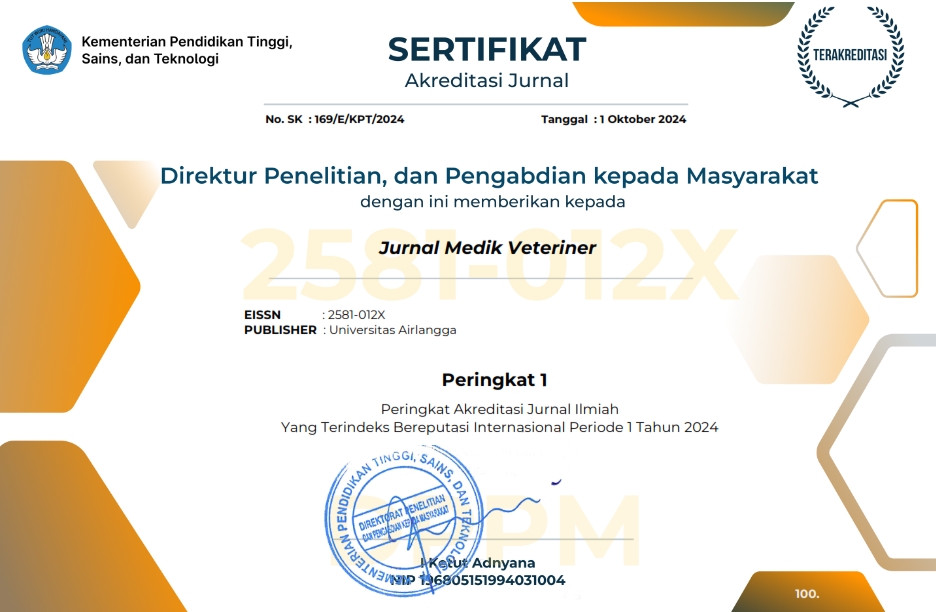Chloramphenicol Residues and Bacterial Contamination in Farmed African Catfish (Clarias gariepinus) from Banyuwangi Traditional Markets: A Risk Assessment

This study aimed to determine chloramphenicol residues and bacterial contamination (Aerobic Plate Count-APC, Escherichia coli count, Salmonella sp., and Vibrio cholerae) in farmed African catfish (Clarias gariepinus) that are marketed in Banyuwangi, Indonesia. A total of ninety samples of C. gariepinus were collected from several markets in Banyuwangi, namely, Kertosari, Blambangan, and Banyuwangi Kota. Using standard procedures, APC, E. coli count, Salmonella sp.,V. cholerae, and chloramphenicol residues were determined. 36.37% of samples from Kertosari markets; 23.33% of samples from Banyuwangi Kota markets; and 16.67% of samples from Blambangan markets contained chloramphenicol residues, but less than 0.3 ppb. Only 40% of samples from Kertosari markets, 36.67% of samples from Banyuwangi Kota markets, and 26.67% of samples from Blambangan markets were contaminated by E. coli, but were less than 3 MPNg-1. The highest APC was from Banyuwangi Kota, followed by Kertosari and Blambangan. No samples were contaminated by Salmonella sp. and V. cholerae from any of the markets, and there was no significant difference between all markets in APC, E. coli count, or chloramphenicol residues. All farmed catfish marketed in Banyuwangi were safe to eat because no samples exceeded the maximum chloramphenicol residue and bacterial contaminant standards. Further studies are needed to detect other antibiotic residues used in aquaculture, including tetracycline, sulphonamide, enrofloxacin, and nitrofuran.
Abebe, E., Gugsa, G., & Ahmed, M. (2020). Review on Major Food-Borne Zoonotic Bacterial Pathogens. Journal of Tropical Medicine, 2020.
Afreen, M., & Ucak, I. (2021). Food-borne pathogens in seafood. Eurasian Journal of Agricultural Research, 5(1), 44–58.
Ali, A., Parisi, A., Conversano, M. C., Iannacci, A., D’Emilio, F., Mercurio, V., & Normanno, G. (2020). Food-borne bacteria associated with seafoods: A brief review. Journal of Food Quality and Hazards Control, 7(1), 4–10.
Antunes, P., Novais, C., & Peixe, L. (2019). Food-to-humans bacterial transmission. Microbial Transmission, 161–193.
Arsène, M. M. J., Davares, A. K. L., Viktorovna, P. I., Andreevna, S. L., Sarra, S., Khelifi, I., & Sergueïevna, D. M. (2022). The public health issue of antibiotic residues in food and feed: Causes, consequences, and potential solutions. Veterinary World, 15(3), 662–671.
Assefa, A., & Abunna, F. (2018). Maintenance of Fish Health in Aquaculture: Review of Epidemiological Approaches for Prevention and Control of Infectious Disease of Fish. Veterinary Medicine International, 2018, 1–10.
Ava, A., Faridullah, M., Lithi, U., & Roy, V. (2020). Incidence of Salmonella and Escherichia coli in fish farms and markets in Dinajpur, Bangladesh. Bangladesh Journal of Scientific and Industrial Research, 55(1), 65–72.
Bortolotte, A. R., Daniel, D., & Reyes, F. G. R. (2021). Occurrence of antimicrobial residues in tilapia (Oreochromis niloticus) fillets produced in Brazil and available at the retail market. Food Research International, 140(3).
Budiati, T., Rusul, G., Wan-abdullah, W. N., Ahmad, R., & Arip, Y. M. (2015). Microbiological Quality of Catfish (Clarias Gariepinus) and Tilapia (Tilapia Mossambica) Obtained from Wet Markets and Ponds in Malaysia. Journal of Aquaculture Research and Development, 6(1), 1–5.
Chowdhury, F., Ross, A. G., Islam, M. T., McMillan, N. A. J., & Qadri, F. (2022). Diagnosis, Management, and Future Control of Cholera. Clinical Microbiology Reviews, 35(3).
Chuah, L. O., Effarizah, M. E., Goni, A. M., & Rusul, G. (2016). Antibiotic Application and Emergence of Multiple Antibiotic Resistance (MAR) in Global Catfish Aquaculture. Current Environmental Health Reports, 3(2), 118–127.
Doğan, Y. N., Pamuk, Ş., & Gürler, Z. (2020). Chloramphenicol and sulfonamide residues in sea bream (Sparus aurata) and sea bass (Dicentrarchus labrax) fish from aquaculture farm. Environmental Science and Pollution Research, 27(33), 41248–41252.
Dumen, E., Ekici, G., Ergin, S., & Bayrakal, G. M. (2020). Presence of Foodborne Pathogens in Seafood and Risk Ranking for Pathogens. Foodborne Pathogens and Disease, 17(9), 541–546.
Duncan, A. E., Adoko, C., Osei-Marfo, M., Barnie, S., Sakyi, A. G., & Adjei, J. (2022). Analysis and Risk Assessment of Pharmaceutical Residues in Fish from Three (3) Water Bodies in Ghana. Journal of Water and Health, 00(3), 1–10.
Ehuwa, O., Jaiswal, A. K., & Jaiswal, S. (2021). Salmonella, food safety and food handling practices. Foods, 10(5), 1–16.
Eissa, F., Ghanem, K., & Al-Sisi, M. (2020). Occurrence and human health risks of pesticides and antibiotics in Nile tilapia along the Rosetta Nile branch, Egypt. Toxicology Reports, 7(3), 1640–1646.
Falaye, A. E., Abah, A., & Sule, S. O. (2024). Effect of Gum Arabic (Acacia senegal) on Growth Performance, Carcass Quality and Health of Clarias gariepinus Juveniles. Jurnal Medik Veteriner, 7(1), 163–176.
Fida, M., Li, P., Wang, Y., Alam, S. M. K., & Nsabimana, A. (2023). Water Contamination and Human Health Risks in Pakistan: A Review. Exposure and Health, 15(3), 619–639.
Fikri, F., Wardhana, D. K., Purnomo, A., Khairani, S., Chhetri, S., & Purnama, M. T. E. (2022). Aerolysin gene characterization and antimicrobial resistance profile of Aeromonas hydrophila isolated from milkfish (Chanos chanos) in Gresik, Indonesia. Veterinary World, 15(7), 1759–1764.
Gauthier, D. T. (2015). Bacterial zoonoses of fishes: A review and appraisal of evidence for linkages between fish and human infections. Veterinary Journal, 203(1), 27–35.
Gufe, C., Canaan Hodobo, T., Mbonjani, B., Majonga, O., Marumure, J., Musari, S., Jongi, G., Makaya, P. V., & Machakwa, J. (2019). Antimicrobial Profiling of Bacteria Isolated from Fish Sold at Informal Market in Mufakose, Zimbabwe. International Journal of Microbiology, 2019.
Hassan, M. M., El Zowalaty, M. E., Lundkvist, Å., Järhult, J. D., Khan Nayem, M. R., Tanzin, A. Z., Badsha, M. R., Khan, S. A., & Ashour, H. M. (2021). Residual antimicrobial agents in food originating from animals. Trends in Food Science and Technology, 111(1), 141–150.
Hu, J., Afayibo, D. J. A., Zhang, B., Zhu, H., Yao, L., Guo, W., Wang, X., Wang, Z., Wang, D., Peng, H., Tian, M., Qi, J., & Wang, S. (2022). Characteristics, pathogenic mechanism, zoonotic potential, drug resistance, and prevention of avian pathogenic Escherichia coli (APEC). Frontiers in Microbiology, 13(12), 1–13.
Ia, S., & Ta, H. (2017). Enterobacteriaceae in Some Imported Fish. Journal of Dairy and Veterinary Sciences, 3(5), 4–9.
Jääskeläinen, E., Jakobsen, L. M. A., Hultman, J., Eggers, N., Bertram, H. C., & Björkroth, J. (2019). Metabolomics and bacterial diversity of packaged yellowfin tuna (Thunnus albacares) and salmon (Salmo salar) show fish species-specific spoilage development during chilled storage. International Journal of Food Microbiology, 293(12), 44–52.
Jajere, S. M. (2019). A review of Salmonella enterica with particular focus on the pathogenicity and virulence factors, host specificity and adaptation and antimicrobial resistance including multidrug resistance. Veterinary World, 12(4), 504–521.
Jayalakshmi, K., Paramasivam, M., Sasikala, M., & Sumithra, A. (2017). Review on antibiotic residues in animal products and its impact on environments and human health. ~ 1446 ~ Journal of Entomology and Zoology Studies, 5(3), 1446–1451.
Jorge, R. J., Redondo, P. N., & Monroy, C. (2016). Bacterial load comparison of marine fish collected and commercially obtained for human consumption in western region of Yucatan Peninsula, Mexico. International Journal of Aquatic Science, 7(1), 6–12.
Kartikasari, A. M., Hamid, I. S., Purnama, M. T. E., Damayanti, R., Fikri, F., & Praja, R. N. (2019). Isolation and identification of Escherichia coli as bacterial contamination in broiler chicken meat in poultry slaughterhouse lamongan district. Jurnal Medik Veteriner, 2(1), 66–71.
Kim, H. W., Hong, Y. J., Jo, J. I., Ha, S. D., Kim, S. H., Lee, H. J., & Rhee, M. S. (2017). Raw ready-to-eat seafood safety: microbiological quality of the various seafood species available in fishery, hyper and online markets. Letters in Applied Microbiology, 64(1), 27–34.
Kyuchukova, R. (2020). Antibiotic residues and human health hazard – review. Bulgarian Journal of Agricultural Science, 26(3), 664–668.
Li, E., Saleem, F., Edge, T. A., & Schellhorn, H. E. (2021). Biological indicators for fecal pollution detection and source tracking: A review. Processes, 9(11).
Lulijwa, R., Rupia, E. J., & Alfaro, A. C. (2020). Antibiotic use in aquaculture, policies and regulation, health and environmental risks: a review of the top 15 major producers. Reviews in Aquaculture, 12(2), 640–663.
Luo, L., Lu, S., Huang, C., Wang, F., Ren, Y., Cao, H., Lin, Q., Tan, Z., & Wen, X. (2021). A survey of chloramphenicol residues in aquatic products of Shenzhen, South China. Food Additives and Contaminants - Part A Chemistry, Analysis, Control, Exposure and Risk Assessment, 38(6), 914–921.
Mohamed, M. Y. I., & Habib, I. (2023). Pathogenic E. coli in the Food Chain across the Arab Countries: A Descriptive Review. Foods, 12(20), 1–18.
Møretrø, T., Moen, B., Heir, E., Hansen, A., & Langsrud, S. (2016). Contamination of salmon fillets and processing plants with spoilage bacteria. International Journal of Food Microbiology, 237, 98–108.
Mumbo, M. T., Nyaboga, E. N., Kinyua, J. K., Muge, E. K., Mathenge, S. G. K., Rotich, H., Muriira, G., Njiraini, B., & Njiru, J. M. (2023). Antimicrobial resistance profiles of Salmonella spp. and Escherichia coli isolated from fresh nile tilapia (Oreochromis niloticus) fish marketed for human consumption. BMC Microbiology, 23(1), 1–18.
Ni, L., Chen, D., Fu, H., Xie, Q., Lu, Y., Wang, X., Zhao, Y., & Chen, L. (2021). Residual levels of antimicrobial agents and heavy metals in 41 species of commonly consumed aquatic products in Shanghai, China, and cumulative exposure risk to children and teenagers. Food Control, 129, 108225.
Novoslavskij, A., Terentjeva, M., Eizenberga, I., Valciņa, O., Bartkevičs, V., & Bērziņš, A. (2016). Major foodborne pathogens in fish and fish products: a review. Annals of Microbiology, 66(1), 1–15.
O’Bryan, C. A., Ricke, S. C., & Marcy, J. A. (2022). Public health impact of Salmonella spp. on raw poultry: Current concepts and future prospects in the United States. Food Control, 132(6), 108539.
Onmaz, N. E., Yildirim, Y., Karadal, F., Hizlisoy, H., Al, S., Gungor, C., Disli, H. B., Barel, M., Dishan, A., Akai Tegin, R. A., & Simsek, E. (2020). Escherichia coli O157 in fish: Prevalence, antimicrobial resistance, biofilm formation capacity, and molecular characterization. Lwt, 133(May), 109940.
Parlapani, F. F. (2021). Microbial diversity of seafood. Current Opinion in Food Science, 37, 45–51.
Prabhakar, P., Lekshmi, M., Ammini, P., Nayak, B. B., & Kumar, S. (2020). Salmonella contamination of seafood in landing centers and retail markets of Mumbai, India. Journal of AOAC International, 103(5), 1361–1365.
Praja, R. N., Yudhana, A., Haditanojo, W., Handijatno, D., Purnama, M. T. E., Maslamama, S. T., Insani, A. K., Prasetyo, D. R., Prameswari, N. P., & Praja, S. S. (2024). Comparison of Bacterial Contamination in Sea Turtle Natural and Semi-natural Hatching Nest at Boom Beach Banyuwangi. The Indian Veterinary Journal, 101(4), 7–11.
Prajwal, S., Vasudevan, V. N., Sathu, T., Irshad, A., & Nayankumar, S. R. (2017). Antibiotic residues in food animals : Causes and health effects. The Pharma Innovation Journal, 6(12), 1–4.
Rahman, M., Alam, M. U., Luies, S. K., Kamal, A., Ferdous, S., Lin, A., Sharior, F., Khan, R., Rahman, Z., Parvez, S. M., Amin, N., Hasan, R., Tadesse, B. T., Taneja, N., Islam, M. A., & Ercumen, A. (2022). Contamination of fresh produce with antibiotic-resistant bacteria and associated risks to human health: A scoping review. International Journal of Environmental Research and Public Health, 19(1), 1–15.
Ramamurthy, T., Nandy, R. K., Mukhopadhyay, A. K., Dutta, S., Mutreja, A., Okamoto, K., Miyoshi, S. I., Nair, G. B., & Ghosh, A. (2020). Virulence Regulation and Innate Host Response in the Pathogenicity of Vibrio cholerae. Frontiers in Cellular and Infection Microbiology, 10(9), 1–22.
Roca-saavedra, P., Mendez-vilabrille, V., Miranda, J. M., Lamas, A., Nebot, C., Cardelle-cobas, A., Franco, C. M., & Cepeda, A. (2016). Food Additives and Contaminants : Effects on Human Gut Microbiota — A Review. Preprints, 2016, 2016120119.
Sheng, L., & Wang, L. (2021). The microbial safety of fish and fish products: Recent advances in understanding its significance, contamination sources, and control strategies. Comprehensive Reviews in Food Science and Food Safety, 20(1), 738–786.
Sora, V. M., Meroni, G., Martino, P. A., Soggiu, A., Bonizzi, L., & Zecconi, A. (2021). Extraintestinal pathogenic Escherichia coli: Virulence factors and antibiotic resistance. Pathogens, 10(11).
Sudin, N. S., Yew, J., & Tang, H. (2018). Detection, Isolation and Antibiotic Testing of Vibrio cholerae in seafood. Journal Of Agrobiotechnology, 9(1), 50–57.
Tahir, N. D. M., Matori, M. F., & Gan, H. M. (2024). First Report of Aeromonas schubertii Infection in Striped Snakehead Channa striata (Bloch, 1793) Fingerlings in Malaysia. Jurnal Medik Veteriner, 7(1), 33–40.
Terajima, J., Izumiya, H., Hara-Kudo, Y., & Ohnishi, M. (2017). Shiga Toxin (Verotoxin)-producing Escherichia coli and Foodborne Disease: A Review. Food Safety, 5(2), 35–53.
Wang, M., Qazi, I. H., Wang, L., Zhou, G., & Han, H. (2020). Salmonella virulence and immune escape. Microorganisms, 8(3), 1–25.
Wardhana, D. K., Haskito, A. E. P., Purnama, M. T. E., Safitri, D. A., & Annisa, S. (2021). Detection of microbial contamination in chicken meat from local markets in Surabaya, East Java, Indonesia. Veterinary World, 14(12), 3138–3143.
Wibawati, P. A., Chrismonica, Y., Susanti, R. B., Himawan, M. P., Sintya Devy, A. H., Nirmalasari, J. A., & Abdramanov, A. (2024). Microbial Contamination in Chicken Meat in Traditional Markets in Banyuwangi. Jurnal Medik Veteriner, 7(1), 41–47.
Wiradana, P. A., Sudyadnyana Sandhika, I., Widhiantara, I. G., Rizqy, A. N., Soegianto, A., & Yulianto, B. (2023). Contaminants and Human Health Risks Associated with Exposure to Microplastic Ingestion of Green Mussels (Perna viridis) Collected from The Kedonganan Fish Market, Bali. Jurnal Medik Veteriner, 6(2), 197–208.
Wong, H. C., Jiang, H. Y., Lin, H. Y., & Wang, Y. T. (2015). Microbiological quality of Seafood marketed in Taiwan. Journal of Food Protection, 78(11), 1973–1979.
Yohans, H., Mitiku, B. A., & Tassew, H. (2022). Levels of Escherichia coli as Bio-Indicator of Contamination of Fish Food and Antibiotic Resistance Pattern Along the Value Chain in Northwest Ethiopia. Veterinary Medicine: Research and Reports, 13, 299–311.
Copyright (c) 2024 Mohammad Faizal Ulkhaq, Hapsari Kenconojati, Darmawan Setia Budi, Maria Agustina Pardede, Jiun-Yan Loh

This work is licensed under a Creative Commons Attribution-NonCommercial-ShareAlike 4.0 International License.
Authors who publish in this journal agree to the following terms:
1. The journal allows the author to hold the copyright of the article without restrictions;
2. The journal allows the author(s) to retain publishing rights without restrictions;
3. The legal formal aspect of journal publication accessibility refers to Creative Commons Attribution-NonCommercial-ShareAlike 4.0 International License (CC BY-NC-SA).






11.jpg)




















